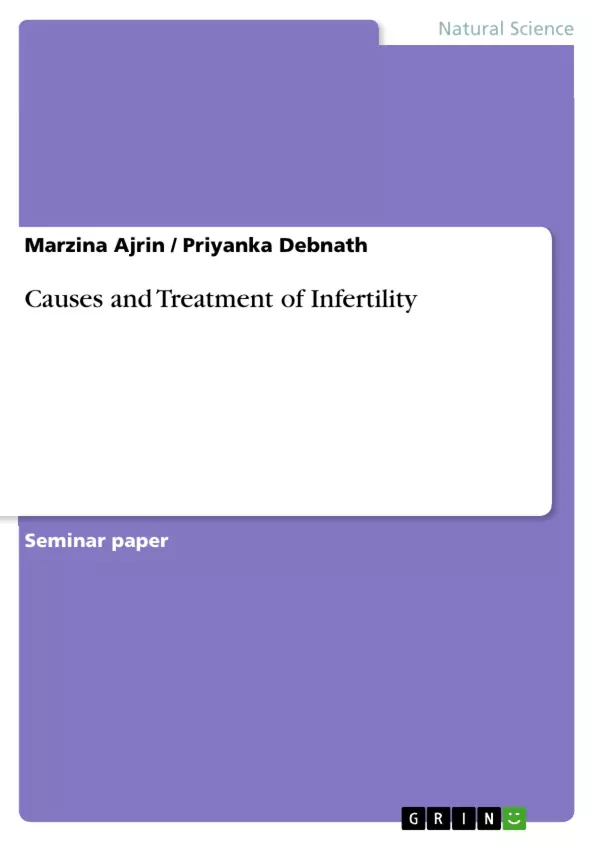The aim of this work is to perform a systematic review of literature to determine the causes and treatment aspects of infertility. This work also aimes to interpret the findings in the context of recent clinical practices and suggest optimal treatment and management aspects regarding infertility.
This review focuses on different factors including the ovulatory factor, utero-tubal peritoneal factor, semen migration factor and the male factor. Some of these infertile conditions are treated as unexplained infertility problems to some extent. This review process deploys a new strategy to translate the recent research findings and evidence-based causes into a simplified focused cause of male and female infertility. The development of molecular biology and biotechnology as well as genetics has profound influence on infertility study on causes, assessment and treatment process.
Infertility is a qualification of a situation where couple has tried to achieve pregnancy for more than one year without success. The basic work-up doesn’t find a reason for the failure in more than 30 percent cases. Many of the defects related to infertility is still unknown.
Inhaltsverzeichnis (Table of Contents)
- CHAPTER ONE
- INTRODUCTION
- 1.1 Background of Infertility
- 1.2 Main causes of infertility
- 1.3 Constraints with Infertility
- 1.4 Genetics of human Male Infertility
- 1.5 Genetics of human Female Infertility
- CHAPTER TWO
- Aim of the Research
- CHAPTER THREE
- METHODOLOGY
- 3.1 Search strategy and identification of studies
- 3.1.1 Other resources
- 3.2 Criteria for considering studies for this review
- 3.2.1 Inclusion Criteria
- 3.2.2 Exclusion Criteria
- CHAPTER FOUR
- FINDINGS AND DISCUSSION
- 4.1 Screening of Articles
- 4.2 Findings from MEDLINE Website
- 4.3 Findings from UM (University of Michigan) LIBRARY DATABASE
- 4.4 Findings from Cochrane Library
- 4.5 Findings from AGORA Website
- 4.6 Discussion
- CHAPTER FIVE
- CONCLUSION
- CHAPTER SIX
- REFERENCES
Zielsetzung und Themenschwerpunkte (Objectives and Key Themes)
This research aims to conduct a systematic review of literature to identify the causes and treatment aspects of infertility. The review interprets the findings in the context of current clinical practices and suggests optimal treatment and management strategies for infertility.
- Defining infertility and its criteria.
- Exploring the various causes of infertility in both males and females.
- Analyzing different factors contributing to infertility, including ovulatory, utero-tubal peritoneal, semen migration, and male factors.
- Investigating the impact of molecular biology, biotechnology, and genetics on infertility studies.
- Evaluating the role of recent research findings and evidence-based practices in understanding infertility.
Zusammenfassung der Kapitel (Chapter Summaries)
- Chapter One: Introduction This chapter provides background information on infertility, defining it as a reproductive system disease affecting individuals' ability to reproduce naturally. The chapter discusses the prevalence of infertility globally and highlights the impact it has on couples' lifestyles and statuses. The chapter also addresses the different factors responsible for infertility, including male, female, and combined factors.
- Chapter Two: Aim of the Research This chapter outlines the primary objective of the research: to conduct a comprehensive review of literature to identify the causes and treatment aspects of infertility, interpret the findings in the context of current clinical practices, and suggest optimal treatment and management strategies.
- Chapter Three: Methodology This chapter details the research methodology, including the search strategy used to identify relevant studies. It describes the inclusion and exclusion criteria used to select articles for the review.
- Chapter Four: Findings and Discussion This chapter presents the findings of the review, analyzing the information obtained from various databases, including MEDLINE, UM Library, Cochrane Library, and AGORA Website. The chapter discusses the key findings related to causes of infertility in males and females and explores the impact of genetic factors. It also examines the effectiveness of current treatment options.
Schlüsselwörter (Keywords)
This research focuses on the key terms and concepts of infertility, genetics, causes, treatment, and management, investigating recent research findings and evidence-based practices in the field.
- Quote paper
- Marzina Ajrin (Author), Priyanka Debnath (Author), 2020, Causes and Treatment of Infertility, Munich, GRIN Verlag, https://www.grin.com/document/535346



